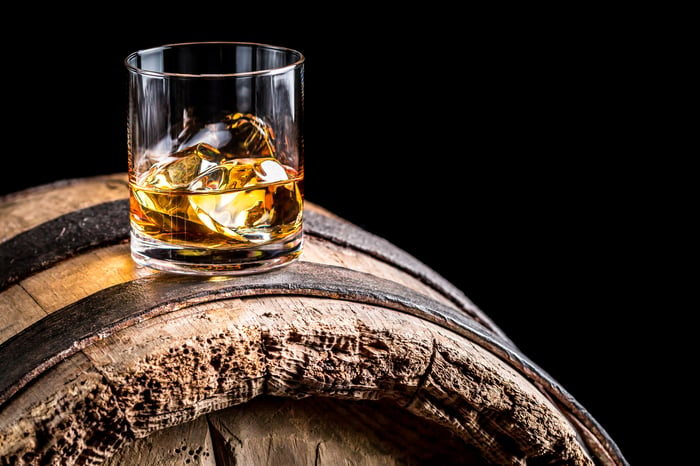"Do you have Johnnie Walker in a bottle? Well, you better let him out!"
That old kids prank is a testament to just how widespread the fame of Johnnie Walker scotch whiskey is. In fact, it is the No. 1 scotch whiskey in the world and it's also where Diageo (DEO -0.99%) makes most of its money.

Image source: Diageo.
Liquid sunshine
One of the world's largest distillers, Diageo garnered a lot of press this summer for spending upwards of $1 billion to buy George Clooney's tiny tequila brand, but tequila is actually one of its smallest segments.
The biggest source of revenue for this giant of the spirits world is scotch whiskey, which represents a quarter of Diageo's $15.9 billion in annual sales. Johnnie Walker is the premier label, but the distiller also owns Buchanan's, which is the second most popular scotch in the U.S.; Black & White, the top seller in Brazil; and J&B, the No. 1 scotch in Spain. It also owns Windsor, Old Parr, and Lagavulin, each of which holds leading positions in various markets around the world.
In an industry where Brown-Forman's (BF.A -1.36%) (BF.B -1.38%) Jack Daniel's is considered the premier American whiskey, it might be worthwhile to distinguish between the two. Actually, three, four, or five. That's because there's also bourbon, rye, and Irish whiskey, all of which are closely related.
A rose by any other name
All whiskey, regardless of how you spell it, is an alcoholic beverage distilled from grain and depending upon the type, has special requirements on how much alcohol by volume it has after fermentation.

Image source: Getty Images.
Scotch whisky, as you might guess, has to be made in Scotland and was originally only made from malted barley, but has since been expanded to also use unmalted wheat and rye. It is aged in oak barrels for at least three years.
Like scotch, bourbon can only be called bourbon if it's made in the U.S., and then primarily in Kentucky, but instead of barley, it must contain at least 51% corn. It has no minimum aging requirements, but to be called straight bourbon it must be aged for no less than two years.
Tennessee whiskey like Jack Daniel's is actually bourbon, but then it is put through what's known as the Lincoln County process (named after Lincoln County, Tenn. where it's made) where it's put through a charcoal filter. In short, all whiskey is bourbon, but not all bourbons are whiskey.
Rye whiskey is a product of Canada and though it doesn't have to contain mostly rye, it has to have at least some. Diageo's Bulleit is the world's best-selling rye whiskey while its Crown Royal (a blend of rye, corn, and barley), is the No. 1 Canadian whiskey.
Last, Irish whiskey has pretty much only one requirement, that it be aged in Ireland; it can contain almost any type of grain, but it does have to be aged in wooden oak casks for at least three years. Diageo sold off its 400-year old Bushmill's brand in a deal with Casa Cuervo to acquire Don Julio tequila; now it's launching a new Irish whiskey because of it rising in popularity once more.

Image source: Getty Images.
An acquired taste
There's a good reason so much emphasis is placed on each category. The so-called "browns" of the spirits world are enjoying renewed popularity, with the Distilled Spirits Council of the U.S. (DISCUS) saying that bourbon, Tennessee whiskey, and rye enjoyed an 8% jump in sales in 2016 to $3.1 billion, with volumes rising 6.8% to 21.8 million cases. Cognac did even better, rising 13% for the year, and Irish whiskey jumped almost 19%.
Scotch sales actually ticked down last year, but that's only because the lower end of the scale has fallen. Much like the rest of the liquor industry, high-end and super-premium blends have been soaring, which explains why Bulleit was called out by Diageo as its top performer, reporting a 43% jump in net sales and 23% organic sales gains.
Yet Diageo obviously isn't a one-trick pony. Beer is actually its second largest contributor to revenues. Guinness, which is the No. 1 stout in the world, saw 18% net sales gains last year.
Vodka comes in third place for the distiller thanks to both Smirnoff and Ciroc, but vodka has fallen out of favor lately after years of booming sales, and it shows just how drinkers' tastes change over time.
A tequila sunrise
It may soon be that whiskey's time in the sun will end too, which explains why Diageo made such a big bet on Clooney's Casamigos. It's still likely the distiller overpaid for the brand, but tequila sales are on a torrid pace higher.
DISCUS says tequila volumes in the U.S. grew from 795,000 9-liter cases in 2006 to 1.6 million cases last year, or about 105% growth. Super-premium tequila sales grew even faster, rising 142% in the same period, but they were coming out of relative obscurity in 2002 to sell 4.5 million cases last year, putting them at about 40% of the sales of value and premium tequilas. Diageo's Don Julio has quickly become one of its top sellers.
The takeaway from the foregoing is that Diageo has a massive, global portfolio of top-ranked brands spanning whiskey (and whisky), beer, vodka, rum, gin, and tequila. Take a look in your liquor cabinet, and it's probable you have at least one Diageo brand in there. That's something worth toasting for Diageo investors.





